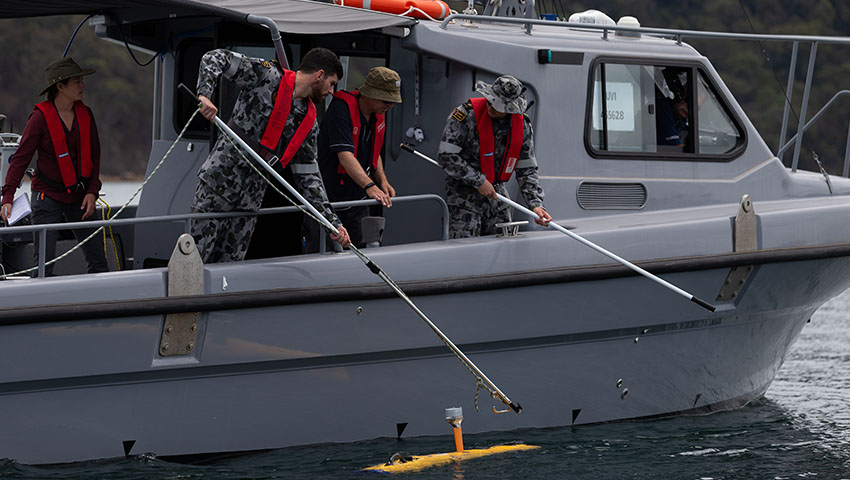The Royal Australian Navy’s minehunter teams are evolving with the times, with a range of new technologies as part of a technological leap through the introduction of a deployable mine countermeasures (MCM) capability under Project SEA 1778.
To continue reading the rest of this article, please log in.
Create free account to get unlimited news articles and more!
Under Project 1778 Phase One, Australian Mine Warfare Team 16 (MWT 16) was commissioned to operate a suite of autonomous underwater vehicles (AUV), unmanned surface vessels (USV), expendable mine neutralisation systems, and mine countermeasures (MCM) support craft.
The team is paving the way to the future by introducing into service this new MCM technology, which is revolutionising Navy’s approach to maritime mine warfare.
The first ‘roll out’ of equipment will be the man-portable ‘Bluefin-9’ AUV, which MWT 16 is undergoing pilot training on at Sydney’s Pittwater.
Commander Mine Warfare, Clearance Diving, Hydrographic, Meteorological, Oceanographic and Patrol Force (COMMHP), Captain Bryan Parker, explained that the Task Group MCM capability aimed to provide a tactical capability essential to reducing the hazard of mines in the littoral maritime domain for Navy’s deployed Fleet, while aiming to minimise the direct exposure of its personnel to dangerous sea mines.
CAPT Parker said, "By its very nature, MCM operations are a time consuming task and conventional minehunters have a relatively slow speed of advance compared to our other warships. We are aiming to provide an MCM capability in-stride with, or in some cases ahead of, deploying maritime task groups to effectively speed up the time taken on this important function and enabling maritime manoeuvre.
"There’s a global up-swell of interest and enthusiasm in what we’re doing with the use of remote and autonomous systems (with potential for significant embedded artificial intelligence) because of the diversity and complexity of sea mine types available, the dangers they pose to our current and future fleet, and the need to ensure the safety [of] our people involved in MCM operations."
Commanding Officer of MWT 16, Lieutenant Commander John Sutherland, said Navy’s joint commitment to training with Defence Science and Technology Group (DSTG) and industry partners such as the Australian Maritime College, was bolstering the team’s capacity to hit the initial operating capability milestone.
"We’ve been working with partners to upskill our people in the operation of AUV technology and provide them with invaluable underpinning AUV knowledge required to execute activities," LCDR Sutherland said.
He said the new autonomous and unmanned technologies will allow Navy to search for, classify, identify and dispose of sea mines more safely and efficiently and limit the danger factor presented when personnel are directly involved in mine removal and destruction.
"There’s a lot of training, testing and trialling involved, but we’re all aware of the significance of this new generation of technology. The team are making an important contribution to Navy’s leading edge capability and mission to fight and win at sea," LCDR Sutherland said.
MWT 16 will officially commence receiving their new technology suite later this year, which will include four Bluefin-9 AUVs, three Bluefin-12 AUVs, two unmanned surface vessels for remote influence minesweeping, three MCM support boats, and the Seafox Expendable Mine Neutralisation System.
The need for leading-edge sea mine countermeasure technology is a stark reality for Australia as a maritime nation, which is heavily reliant on sea trade.
According to the Department of Infrastructure, Transport, Regional Development and Communication, 99 per cent of Australia’s exports are via sea trade.

 Login
Login







